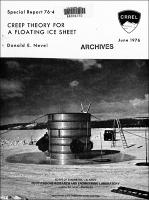Please use this identifier to cite or link to this item:
https://hdl.handle.net/11681/22903Full metadata record
| DC Field | Value | Language |
|---|---|---|
| dc.contributor.author | Nevel, D. E. | - |
| dc.date.accessioned | 2017-09-05T20:10:29Z | - |
| dc.date.available | 2017-09-05T20:10:29Z | - |
| dc.date.issued | 1976-06 | - |
| dc.identifier.uri | http://hdl.handle.net/11681/22903 | - |
| dc.description.abstract | The problem investigated in this thesis is the prediction of the deflection and stresses in a floating ice sheet under loads which act over a long period of time. This problem is currently important for oil exploration offshore in the Arctic. A review of analytical methods for predicting the bearing capacity of an ice sheet is given. The problem is formulated by assuming the ice is isotropic with a constant Poisson's ratio. The shear modulus is assumed to obey a linear viscoelastic model. The specific model selected is a series of one Maxwell model and two Voigt models. One of the Voigt models has a negative spring constant which produces tertiary creep. The ice model exhibits a primary, secondary, and tertiary creep response, similar to that observed in uniaxial creep tests of ice. The material properties in the viscoelastic model may be a function of the vertical position in the ice sheet, but all these material properties must be proportional to the same function of position. Using the thin-plate theory for the floating ice sheet, the solution is obtained for the deflection and stresses in the ice sheet for primary, secondary, and tertiary creep regions. It is then shown that for a load that is not distributed over a large area, the time-dependent part of the deflection and stresses is relatively independent of the load's distribution. For the elastic case, the stress significantly depends upon the load's distribution. Results are given for the deflection and stresses as a function of time and distance from the load. The maximum deflection and stresses occur at the center of the load. At this point the deflection increases with time, while the stresses decrease; i.e., the stresses relax. | en_US |
| dc.language.iso | en | en_US |
| dc.publisher | Cold Regions Research and Engineering Laboratory (U.S.) | en_US |
| dc.relation.ispartofseries | Special Report;76-4 | - |
| dc.subject | Ice--Testing | en_US |
| dc.subject | Creep | en_US |
| dc.subject | Failure | en_US |
| dc.title | Creep theory for a floating ice sheet | en_US |
| dc.type | Report | en_US |
| Appears in Collections: | Special Report | |
Files in This Item:
| File | Description | Size | Format | |
|---|---|---|---|---|
| Special Report 76-4.pdf | 12.33 MB | Adobe PDF |  View/Open |